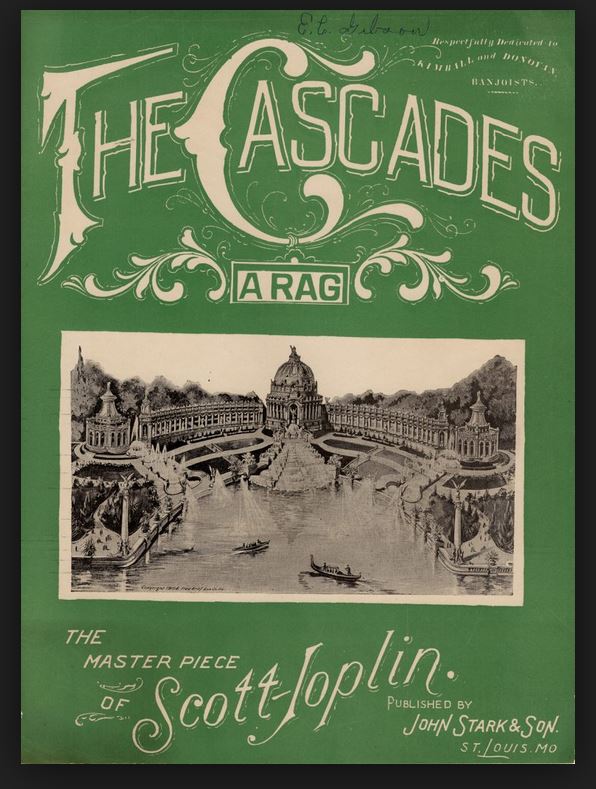
In 1878, Mr. William Lyman Thomas became a member of the Missouri Press Association. In 1880, he was elected treasurer and held that position for twenty four consecutive years. At the end of his service he was made a life member. The only other life member, since the death of Samuel L. Clemens (Mark Twain, d. 1910), was J. West Goodwin of the Sedalia Bazoo newspaper, whose slogan was, “Whoso tooteth not his own Bazoo, the same it shall not be tooted”.
John Stillwell Stark knew J.West Goodwin and definitely learned to toot his own Bazoo along with the Bazoos of many other folks as well. Goodwin and Stark were active businessmen at the same time in Sedalia. Stark operated a music store and advertised regularly in the Bazoo.
Born in 1841 in Kentucky, Stark began his working life as a farmer. The 1860 census lists him as a laborer on a farm in Bean Blossom, Indiana. He was sent to New Orleans as a bugler after joining the Union Army in 1863. It was there that he met the woman who would become his wife, British born, Sarah Ann Casey. He was just 23 and she was 9 ½ years younger. They were married in 1865. Following his discharge from the army, they moved to Missouri in 1868. The 1870 census list them and their two children, Etilmon Justus (named after his brother) and William Paris living on their own homestead near Camden, Missouri.
Shortly after 1870 he was wandering around northwestern Missouri selling ice cream to folks in small towns and farmers out of the back of a Conestoga wagon. I have not found how he went from farming to selling ice cream. Apparently he did well enough to provide for his growing family that included Eleanor S. born in 1871.
After a move to Chillicothe in the late 1870’s, Stark added a sideline as a salesman for the Jesse French Piano Company. Along with the ice cream, he sold pianos, organs and possibly other musical instruments to farmers who were eager for culture. It was said he would drop off a piano at a farm for a free trial. By the time he made his way back the farmer would have become attached to it.
The 1880 census locates the Stark family in Chillicothe with John as a salesman of pianos and organs. He also learned how to tune them. Hauling pianos around on spec must not have been much fun. I found an advertisement in the July 4, 1882 issue of the Sedalia Bazoo posted by an apparently well-established John Stark of 219 Ohio St. offering to finance Mason and Hamlin organs with easy payments. This locates him in Sedalia earlier than any of the other references I’ve read.
According to Bill Edwards, of ragpiano.com, Stark bought the failing J.W.Truxel music store in 1886. He then moved to 516 South Ohio St. Included in the purchase were seven copyrights which he decided to continue to sell as well as adding others from local musicians. Stark preferred classically styled instrumentals.
And so it went until a day in August in 1899 when Scott Joplin walked into Stark’s store hoping to sell a song he had written called the Maple Leaf Rag. To make an impression, Joplin had brought a young boy to dance to his own incandescent piano playing. Stark saw potential and agreed to a deal most likely offered by Joplin through his lawyer. Joplin would receive a royalty on each copy sold. Four hundred were printed in St. Louis. It took about a year to sell them. Later estimates put the number of copies eventually sold at near one million.
The story is complicated and I’d encourage anyone interested to do a little research on Joplin and Stark. Limited space prevents me from adding much more. Suffice it to say that both men made quite a bit of money from the sale of the sheet music for Maple Leaf Rag. Stark became a promoter of many other ragtime composers as well. Stark gets the credit for introducing the incredible Scott Joplin to the world.
In 1900, Stark moved to St. Louis to be near the larger market and also his printer which he bought. Sedalia at that time had a population of 20,000. By 1905, Stark saw the action had shifted to New York so he moved his business there. Joplin, who had followed him to St. Louis, was on hand in New York as well.
Stark’s wife, Sarah, became ill. They moved back to St. Louis. She passed away in 1910. Joplin died in 1917. The 1909 Directory of St. Louis County lists “Jno, music, 7377 Maple M” as part of the family of his son (or brother?) Etilman J Stark mus tea (music teacher?). Stark passed away in 1927. The home at 7377 Maple has since been replaced by an apartment building. Stark is also believed to have lived at 7360 Maple. (He definitely did. He died there. DH 12/2/2020)
How did the Stark family wind up in Maplewood? There is evidence that William Lyman Thomas knew J.West Goodwin who knew John Stark. There is a connection.
I’m fairly certain I first learned of John Stark’s residence on Maple from my good friend the late Bill McCoy. The anecdote that Bill told me was that Scott Joplin had come to visit his some time publisher, Mr. Stark. Supposedly the fact that Mr. Joplin was a negro scandalized the neighborhood. I believe Bill heard this story from Rita Kippenberger who lived nearly her whole life on Maple. Whether or not it is true, I have no idea.
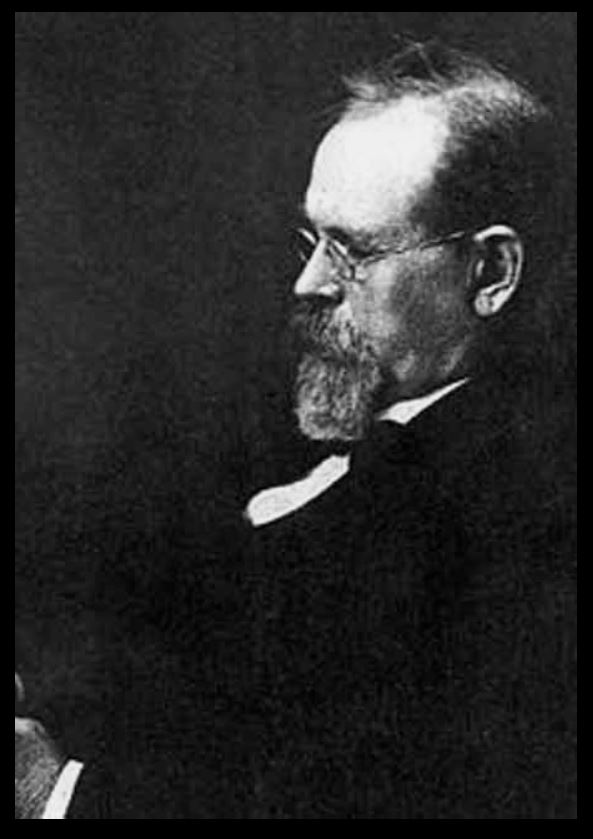
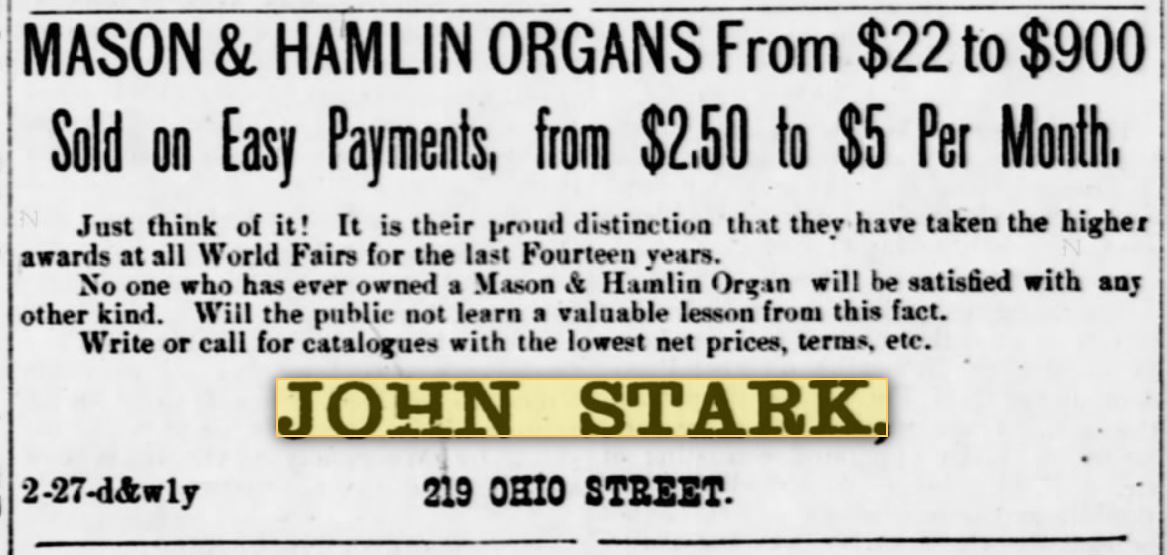
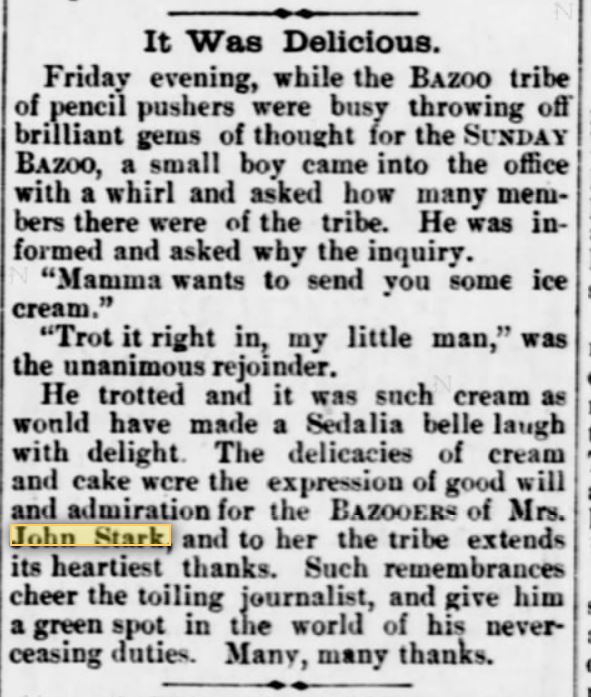
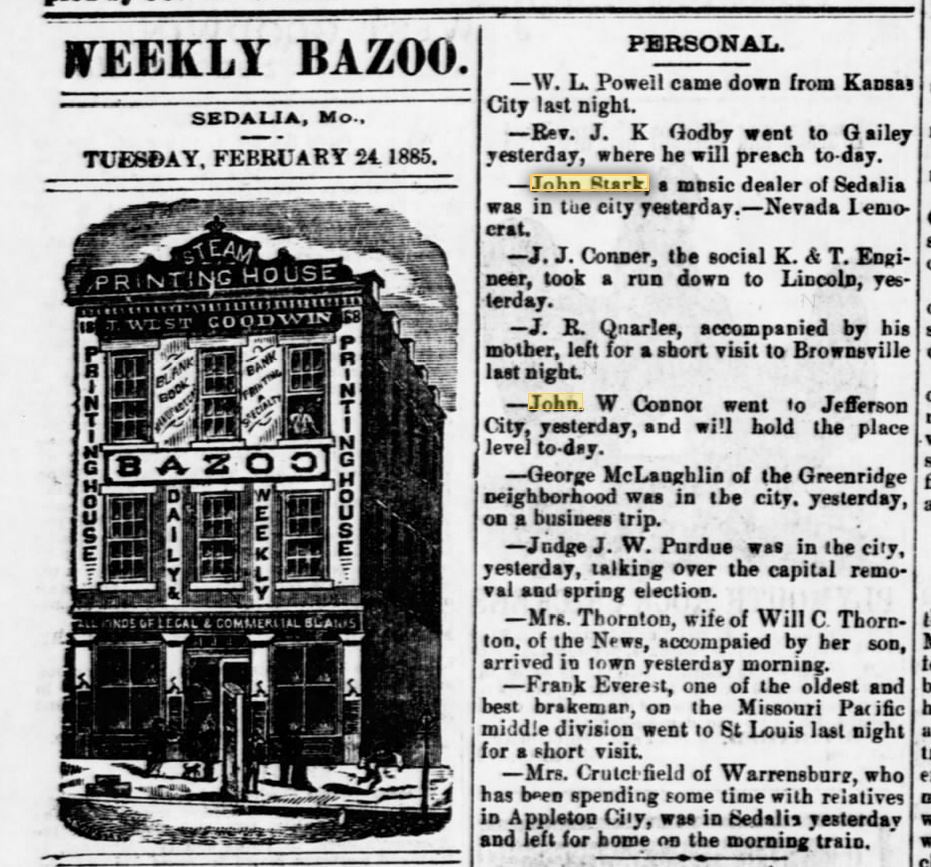

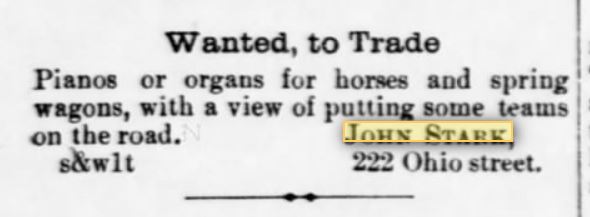
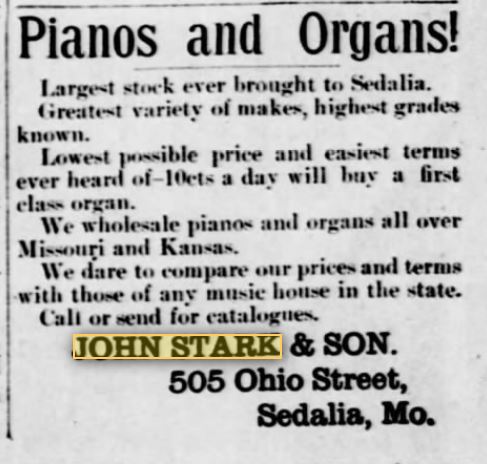
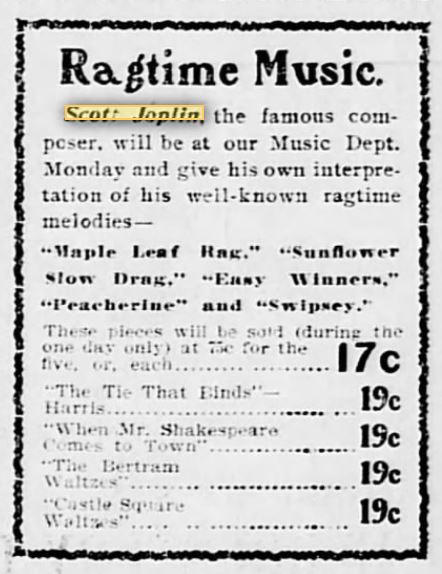



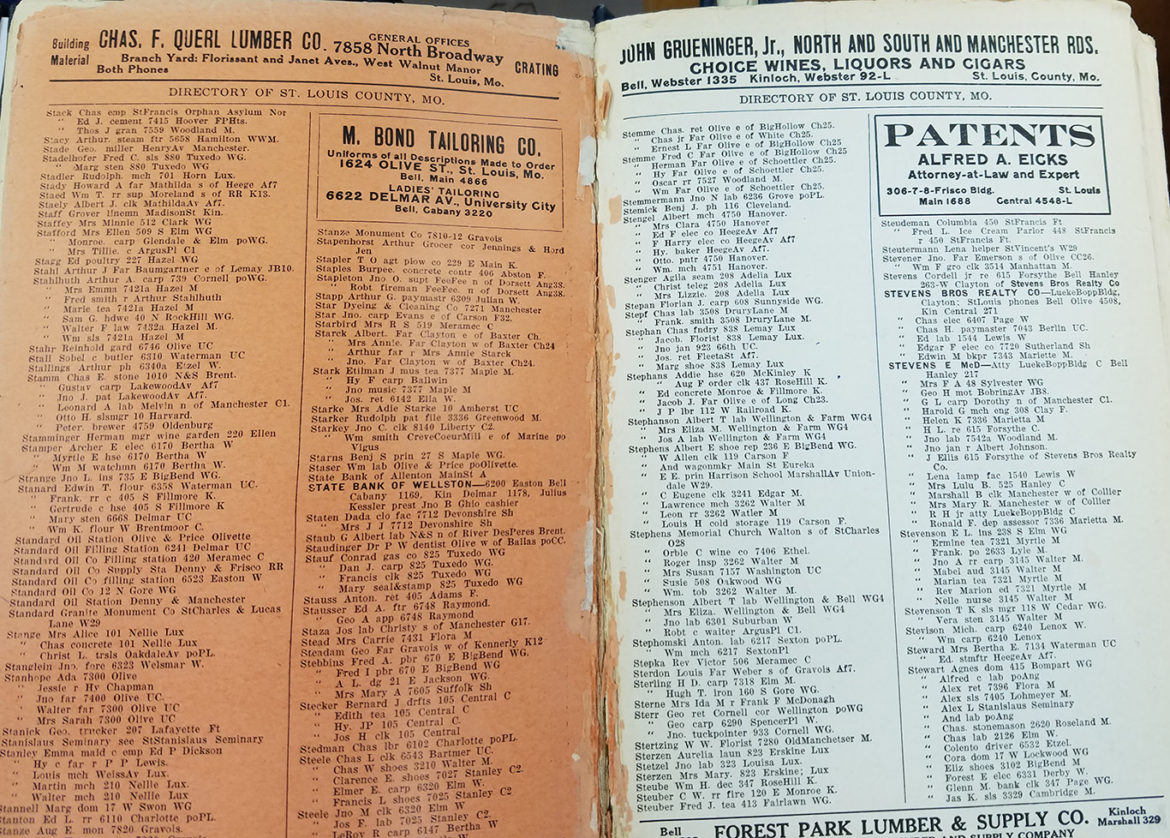
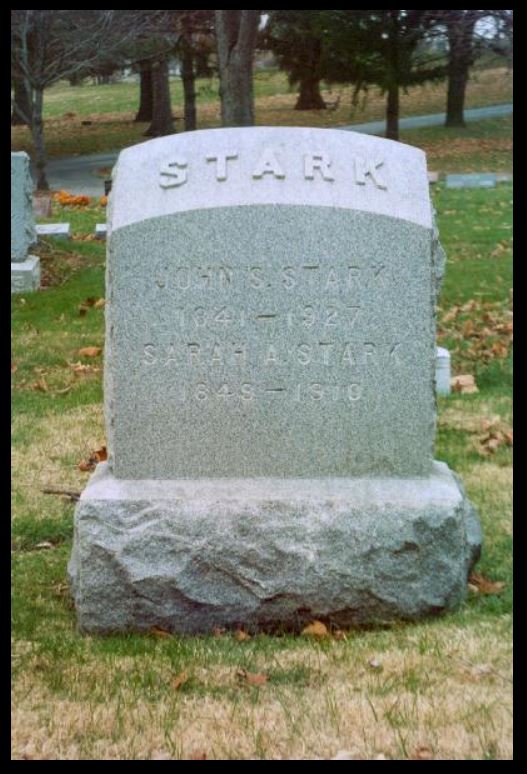

Excellent article. I knew about John Stark, publisher of Scott Joplin’s music, but I didn’t know about his Maplewood residence. John Stark Printing was still in existence as of 2004 when it went into bankruptcy. Was that the end of the company or is it still around?
Gary, I found an article about the bankruptcy of the Stark Printing Company in the St. Louis Post-Dispatch and also an advertisement for the sale of their equipment. Both were in 2004. There was no evidence of the existence of the company after that. Thanks for your question.
Doug, I am wondering if EJ.Stark, who had a pharmacy at Manchester and Marshall, where the little park is located if he was related to this Stark. He was there in the 40’s, 50’s and at least the 60’s. I would deliver prescriptions on the week end on my bike in the 1950’s. Jim Vogelsang
That is interesting, Jim. I never knew the pharmacist’s last name. When he lost his location at what is now Citizen’s Park,he moved directly across Marshall to the building now occupied by Foundation Grounds. When the Shop’N’Save building (now Schnucks) was completed, I believe he was offered a job in their pharmacy. I talked to him around that time. He offered me a copy of the 1912 Maplewood directory but we already had one so he kept it. The initials, E.J., certainly seem like too much of a coincidence what with John Stark’s brother and son both being named Etilmon Justus. If that was his name he is, no doubt, family. A quick Google search reveals how extremely unusual is the name, Etilmon. Absolutely NO other examples come up other than those of the Stark family. I wonder how many other first names this would be true of? How cool is that? Maplewood history includes one of the rarest first names in the English language.
I love these articles! So much interesting information about Maplewood. Thank you Doug.
You are very welcome, Nancy. Thank you for your enthusiastic support.
Not quite as scary as it sounds. The tombstone says she was born in 1849, and I think they married in 1865. So she might have been 16, which certainly sounds better than 13 or 14…
Good thinking, Donna. It’s good to hear from you.
Doug, I knew about the ice houses but wondered how much ice you could keep and store in a Conestoga wagon. Not sure if the piano and the ice cream business were in the wagon at the same time or not but thinking there could not be too much room left for other things in there. Just had never thought about ice cream being served out of a Conestoga wagon before.
As for our race relations from back in the years it seems so hard to imagine even tho I grew up around that same time but in a much different area. Our schools were integrated when I went to school but since I did not go to the town swimming pool I have no idea about that. Our farm ponds and river were our swimming pools. The town had a section of town that was where the Negro/black/African Americans lived-I really don’t want to offend anyone but I am not sure how to refer to this distincation of people. So many of the folks I knew from school seemed to be able to do everything I could do but it may have only looked that way. I have to guess Maplewood was probably the same way.
Those are all very good questions, Mark. As I said it is a complicated story. According to one source he was 23 and she was 13 when they married. The tombstone reads 1841 as his birth date and 1849 as hers. That’s 8 years. A little better. It was a different era. We can scarcely imagine what it would have been like just to be alive then much less their particular circumstances.
I don’t think they had any refrigeration equipment but they had ice. It was cut from the rivers and ponds in the winter and stored in ice houses in the warm months. They were insulated with sawdust and cork. I was lucky once to closely examine about an 1870’s house on McCausland (a block-and-a-half north of Manchester). In the basement was an early large ice box. It had oak doors about 8 inches thick that were filled with sawdust. I suspect that the Starks had one of those in their Conestoga (They moved pianos in it). Then they probably used one of the old fashioned (to us) ice cream makers operated by a hand crank. I suspect it was a new and novel invention at the time.
Joplin and Stark’s relationship is complicated. Stark did not have exclusive rights to Joplin’s material. Joplin used other publishers as well. They had had a major breakthrough hit with The Maple Leaf Rag. I suspect Joplin wanted to be close to Stark with whom he probably had many negotiations not all of which were fruitful. It was definitely Stark who moved to St. Louis (in 1900) from Sedalia first. He wanted to streamline his printing set up. He had some trouble with his printing company, Westover. He wound up buying them. By 1905, the St. Louis World’s Fair was over. Their market in St. Louis was cooling. Stark decided he’d need to move to New York in order to compete with the “Tin Pan Alley” publishers. Joplin followed him there as well. Most likely for the reason I mention above. Joplin put a lot of energy into his opera, Treemonisha. He had no success with it. Like everything, the market for the rags was cooling. Remember, this was sheet music. Neither Joplin or Stark seemed to anticipate the soon-to-be market in recorded music. They peaked just as it was starting. That’s a shame. Joplin was described as a dazzlingly, gifted piano player. I don’t think that any recordings exist of his playing.
At least one of my sources puts Stark’s move back to St Louis as 1910. It could have been earlier than that. His wife had fallen ill. She passed in 1910. As I have shown above the 1909 Boos’ Directory of St. Louis County lists him living with his brother at 7377 Maple. It lists “Jno music 7377 Maple”. I’m assuming that’s him but it may not be. I suppose it could be his brother’s son or possibly a grandson. More research is needed. Documentation is coming that he lived across the street at 7360 Maple.
Frank Wood was about 90 years old when I met him in the early 1980’s. He had heard a story when he moved to Maplewood in the 1950’s that it had been a “sundown” town. From my first Maplewood history book, pg 116, “1916 The District buys land at 8023 Dale for the new 2 room frame Lincoln School for Negroes. Until 1923 only one room is used.” I believe it was sometime in the early 1960’s before the Maplewood Pool was finally declared open to everyone. Prior to that, African/Americans were not admitted. When I produced the first Maplewood history book, I deliberately did not separate African/American residents and workers into a single chapter. There lives were as woven into the fabric of the community as anyone else’s. I wanted to represent them in this manner. The information was hard to get. One African/American woman, who had been a teacher, was suspicious that I would be exploitative of their history. Rightfully so. After centuries of exploitation who wouldn’t be suspicious? Their family photographs and photographs depicting them at work are extremely rare. I regard each photograph that I was able to find as a treasure. I think there were only six or seven.
I asked interview subjects for their recollection of the experience of African/Americans in our community. One woman said her memories wouldn’t be good. She recalled one time at the Forest Park Highlands when a Negro nanny was not allowed to ride the merry-go-round with the young white girl she had brought. She didn’t want to volunteer any more information than that.
One Maplewoodian, who had had a prominent medical career, when asked where did the African/Americans live in our community was very blunt. “In N——town” was his answer. I assume this was the area in Maplewood and Richmond Heights that was recently replaced by Walmart, Lowes and adjacent development on Hanley.
Many fine people are working to bridge this chasm between white and black folks that is our legacy from racism and slavery. Progress is being made but the chasm is still far from bridged. Thank you for your questions.
Doug, Gary here, have you looked into the history of Thomas Skinker? Although not of Maplewood directly, his land was the foundation of the Ellenwood neighborhood and Forest Park.
d
Hey Gary, I have not looked into the history of Thomas Skinker. I am unaware of a connection between him and Maplewood. There must have been. He was so close. If when you say Ellenwood, you mean Ellendale, I do not know of an historic connection of Thomas Skinker to the Ellendale neighborhood. I do not know what the modern boundaries of the neighborhood are. Ellendale, the subdivision was created by William Lyman Thomas and his wife, Kate from their inherited share of her father’s, James Sutton, farm. This NE corner of his farm lies outside the boundary of Maplewood. To my knowledge none of the first subdivision of Ellendale was on land that had belonged to Thomas Skinker. I’d be interested in any information you or anyone else might find indicating that. Hope this helps. It is good to hear from you.
https://40southnews.com/maplewood-history-ellendale-home-place/
Interesting story to read. I did the math and it seems if Stark was 23 and his wife was 9 1/2 years younger he married a 13 or 14 year old. I cannot imagine that happening but it did. I would not think I would let my 13 year old daughter date let alone marry.
The other thing is selling ice cream out of the back of a Conestoga wagon. How did that happen? Where did they get the ice to make and sell ice cream all year long. How did the ice last and such. I don’t know why but I thought ice cream was much more of an invention that went along with electricity and being able to keep things frozen.
Last thing is I am confused by your line about Joplin following Stark to St Louis. Are you saying in the general town of St Louis or did he live in Maplewood somewhere also? From your story about the outcry of Joplin visiting Stark I cannot imagine him living here in Maplewood.
Was Maplewood considered what I have heard of as a sundown city. A Negro was welcome to come thru town, maybe work here but had to be out of town by sundown. Was there a section or side of town that was delegated as the place where a Negro could live? I have not heard os such a thing but that was a long time ago and may have been forgotten.